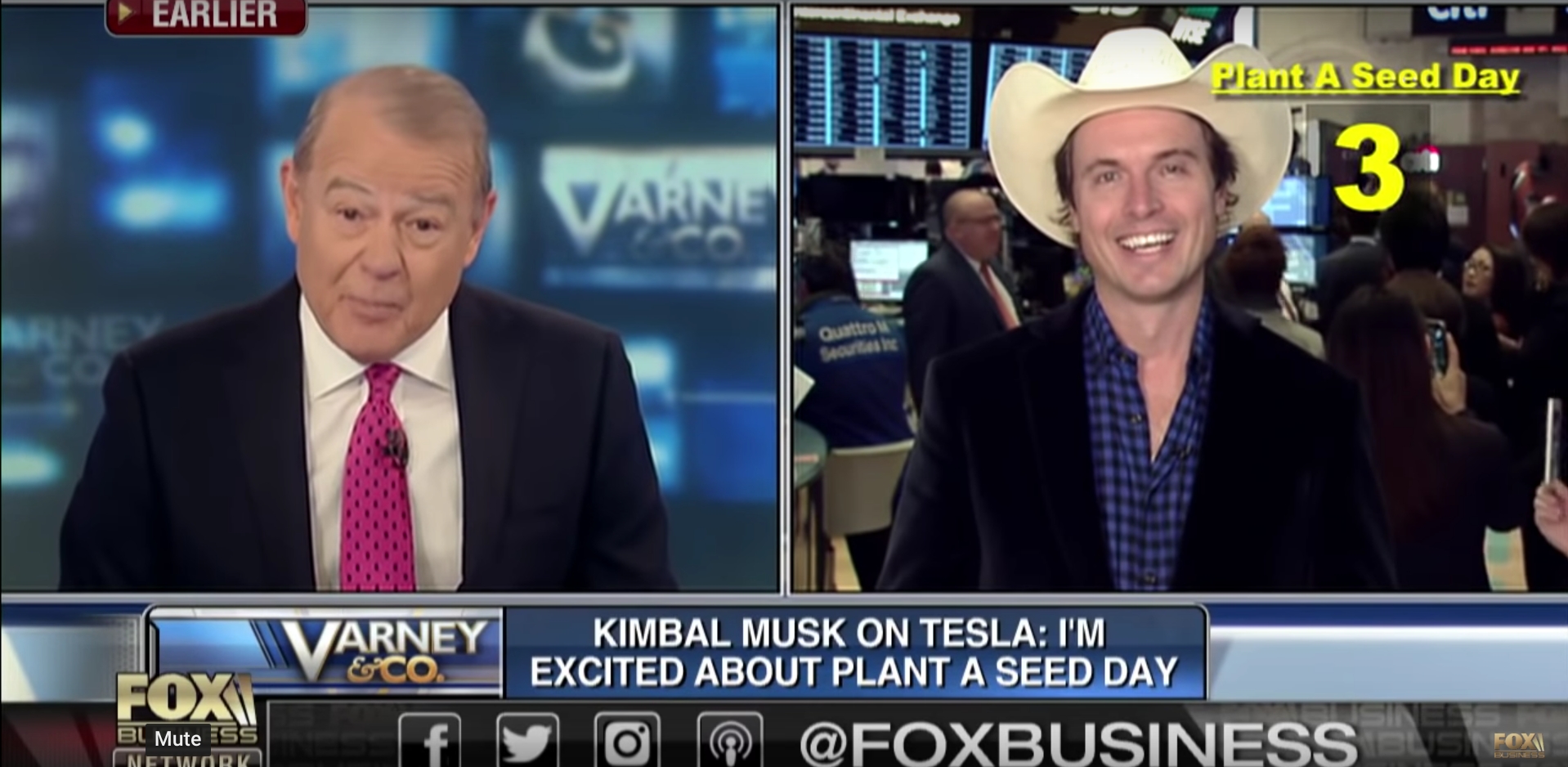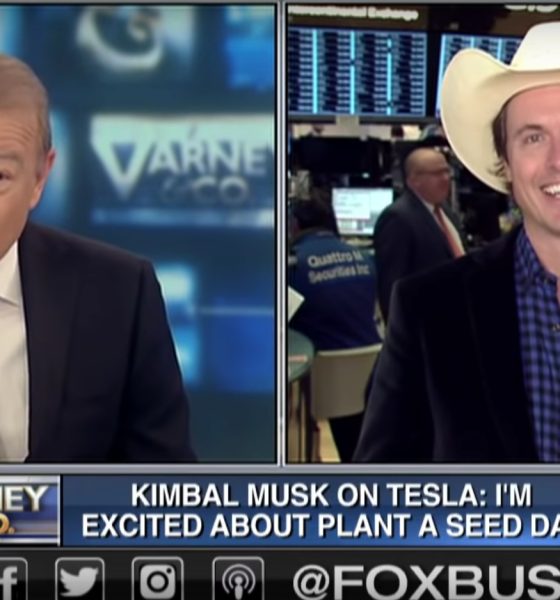

News
Kimbal Musk trolls Fox with ‘Plant a Seed Day’ in exchange about Tesla’s new chair
It appears that the art of trolling runs deep between the Musk brothers. While Elon Musk is known to troll on Twitter from time to time, the trolling chops of Kimbal Musk have mostly been untapped. That is, of course, until recently, when Kimbal ended up aggravating Fox Business Network host Stuart Varney by trolling him with a barrage of plugs for “Plant a Seed Day,” an initiative from his nonprofit, Big Green, that aims to encourage American families to plant a seed on March 20, 2019.
During the amusing segment, the Fox Business host attempted to ask Kimbal about Robyn Denholm’s activities as Tesla’s new chair. Denholm, who has been with the board since 2014, and who has experience in both tech and auto companies as a finance executive, was named earlier this month as a replacement for the outgoing Elon Musk, who was forced to vacate his Chairman post as part of his settlement with the SEC. Denholm’s appointment was widely supported by Elon Musk and Tesla’s supporters, who noted that he was looking forward to working closely with the finance veteran.
It did not take long before Denholm’s appointment attracted some creative speculations among Tesla’s critics. Headlines such as “Tesla’s New Chair Is Part of the Furniture,” “Tesla’s New Chair Won’t Do Much to Rein In Elon Musk,” and “Taming Elon Musk: New Tesla chair, board members face a tough job” have been prevalent since Denholm’s appointment, suggesting that there might be a certain degree of conflict between Musk and the new chair as she attempts to keep the CEO in line.
Varney’s questions towards Kimbal Musk during the short-lived interview suggest that he was traversing a similar line. “Look, Kimbal, you are on the board at Tesla. And you’ve got a new chair. Have you heard anything from her? You’ve got to tell me, is she laying down the law? Have you had contact with her? What’s she saying? What’s she doing on the board?” the Fox Business host asked.
Kimbal Musk, for his part, proved immovable, simply stating that he was “so happy for the future of Tesla.” He also mentioned Plant a Seed Day on March 20, 2019, where his nonprofit, Big Green, aims to get a million American families to plant a seed in their backyards. During the course of the brief interview, Kimbal plugged Plant a Seed Day five times, much to the chagrin of the Fox Business host.
A visibly upset Varney eventually decided to throw in the towel, saying “You think my viewers want to learn about plant a seed day? Do you really? They don’t care, Kimbal. They don’t care!” Kimbal, for his part, continued plugging Plant a Seed Day, stating that the event is “going to be awesome.” At that point, Varney opted to cut the interview.
“Okay, okay. I’m wrapping it up, I’m sorry. Wait a minute, I am responsible to my audience. I’m sorry it’s over. I will not be used,” Varney said, visibly aggravated.
Plant a Seed Day is being coordinated by Big Green, Kimbal Musk’s nonprofit whose mission is to promote and foster a healthy food lifestyle for America’s schoolchildren. A centerpiece of Big Green’s initiatives is the Learning Garden, which are modular gardens that are set up in schools where children could plant and harvest crops. In a blog post on Medium, Kimbal noted that Plant a Seed Day is working with “national and international distribution, brand, and sponsorship partners” to get over 1 million seeds to families for March 20, 2019.
“At Big Green, when my team works with a new Learning Garden school, we encourage teachers to have their students draw out their dream garden. It’s one of my favorite activities because this is when the magic begins. Kids will draw unicorns watering tomato plants, banana trees growing next to their school, or plants that talk, walk, and water themselves. The creativity and energy put toward creating a dream garden is endless. Soon the children realize the real magic of a garden is in planting a seed, watering it, caring for it, and watching it grow.
“Planting a seed is the first and powerful step to making a big change in food education. We have seen this critical step taken thousands of times in the schools we work with through Big Green. On March 20, 2019 we will bring those magical moments to millions of children.”
To learn more about Plant a Seed Day, click here.
Watch Kimbal Musk’s short-lived interview with Fox Business below.

News
Tesla China quietly posts Robotaxi-related job listing
Tesla China is currently seeking a Low Voltage Electrical Engineer to work on circuit board design for the company’s autonomous vehicles.

Tesla has posted a new job listing in Shanghai explicitly tied to its Robotaxi program, fueling speculation that the company is preparing to launch its dedicated autonomous ride-hailing service in China.
As noted in the listing, Tesla China is currently seeking a Low Voltage Electrical Engineer to work on circuit board design for the company’s autonomous vehicles.
Robotaxi-specific role
The listing, which was shared on social media platform X by industry watcher @tslaming, suggested that Tesla China is looking to fill the role urgently. The job listing itself specifically mentions that the person hired for the role will be working on the Low Voltage Hardware team, which would design the circuit boards that would serve as the nervous system of the Robotaxi.
Key tasks for the role, as indicated in the job listing, include collaboration with PCB layout, firmware, mechanical, program management, and validation teams, among other responsibilities. The role is based in Shanghai.
China Robotaxi launch
China represents a massive potential market for robotaxis, with its dense urban centers and supportive policies in select cities. Tesla has limited permission to roll out FSD in the country, though despite this, its vehicles have been hailed as among the best in the market when it comes to autonomous features. So far, at least, it appears that China supports Tesla’s FSD and Robotaxi rollout.
This was hinted at in November, when Tesla brought the Cybercab to the 8th China International Import Expo (CIIE) in Shanghai, marking the first time that the autonomous two-seater was brought to the Asia-Pacific region. The vehicle, despite not having a release date in China, received a significant amount of interest among the event’s attendees.
Elon Musk
Elon Musk and Tesla AI Director share insights after empty driver seat Robotaxi rides
The executives’ unoccupied tests hint at the rapid progress of Tesla’s unsupervised Robotaxi efforts.

Tesla CEO Elon Musk and AI Director Ashok Elluswamy celebrated Christmas Eve by sharing personal experiences with Robotaxi vehicles that had no safety monitor or occupant in the driver’s seat. Musk described the system’s “perfect driving” around Austin, while Elluswamy posted video from the back seat, calling it “an amazing experience.”
The executives’ unoccupied tests hint at the rapid progress of Tesla’s unsupervised Robotaxi efforts.
Elon and Ashok’s firsthand Robotaxi insights
Prior to Musk and the Tesla AI Director’s posts, sightings of unmanned Teslas navigating public roads were widely shared on social media. One such vehicle was spotted in Austin, Texas, which Elon Musk acknowleged by stating that “Testing is underway with no occupants in the car.”
Based on his Christmas Eve post, Musk seemed to have tested an unmanned Tesla himself. “A Tesla with no safety monitor in the car and me sitting in the passenger seat took me all around Austin on Sunday with perfect driving,” Musk wrote in his post.
Elluswamy responded with a 2-minute video showing himself in the rear of an unmanned Tesla. The video featured the vehicle’s empty front seats, as well as its smooth handling through real-world traffic. He captioned his video with the words, “It’s an amazing experience!”
Towards Unsupervised operations
During an xAI Hackathon earlier this month, Elon Musk mentioned that Tesla owed be removing Safety Monitors from its Robotaxis in Austin in just three weeks. “Unsupervised is pretty much solved at this point. So there will be Tesla Robotaxis operating in Austin with no one in them. Not even anyone in the passenger seat in about three weeks,” he said. Musk echoed similar estimates at the 2025 Annual Shareholder Meeting and the Q3 2025 earnings call.
Considering the insights that were posted Musk and Elluswamy, it does appear that Tesla is working hard towards operating its Robotaxis with no safety monitors. This is quite impressive considering that the service was launched just earlier this year.
Elon Musk
Starlink passes 9 million active customers just weeks after hitting 8 million
The milestone highlights the accelerating growth of Starlink, which has now been adding over 20,000 new users per day.

SpaceX’s Starlink satellite internet service has continued its rapid global expansion, surpassing 9 million active customers just weeks after crossing the 8 million mark.
The milestone highlights the accelerating growth of Starlink, which has now been adding over 20,000 new users per day.
9 million customers
In a post on X, SpaceX stated that Starlink now serves over 9 million active users across 155 countries, territories, and markets. The company reached 8 million customers in early November, meaning it added roughly 1 million subscribers in under seven weeks, or about 21,275 new users on average per day.
“Starlink is connecting more than 9M active customers with high-speed internet across 155 countries, territories, and many other markets,” Starlink wrote in a post on its official X account. SpaceX President Gwynne Shotwell also celebrated the milestone on X. “A huge thank you to all of our customers and congrats to the Starlink team for such an incredible product,” she wrote.
That growth rate reflects both rising demand for broadband in underserved regions and Starlink’s expanding satellite constellation, which now includes more than 9,000 low-Earth-orbit satellites designed to deliver high-speed, low-latency internet worldwide.
Starlink’s momentum
Starlink’s momentum has been building up. SpaceX reported 4.6 million Starlink customers in December 2024, followed by 7 million by August 2025, and 8 million customers in November. Independent data also suggests Starlink usage is rising sharply, with Cloudflare reporting that global web traffic from Starlink users more than doubled in 2025, as noted in an Insider report.
Starlink’s momentum is increasingly tied to SpaceX’s broader financial outlook. Elon Musk has said the satellite network is “by far” the company’s largest revenue driver, and reports suggest SpaceX may be positioning itself for an initial public offering as soon as next year, with valuations estimated as high as $1.5 trillion. Musk has also suggested in the past that Starlink could have its own IPO in the future.








